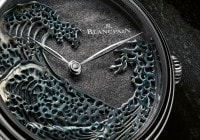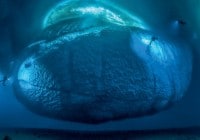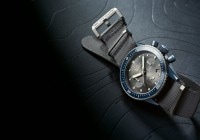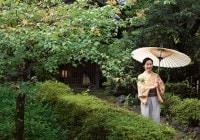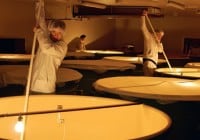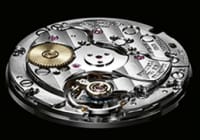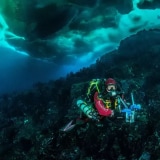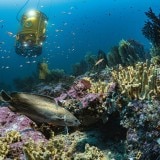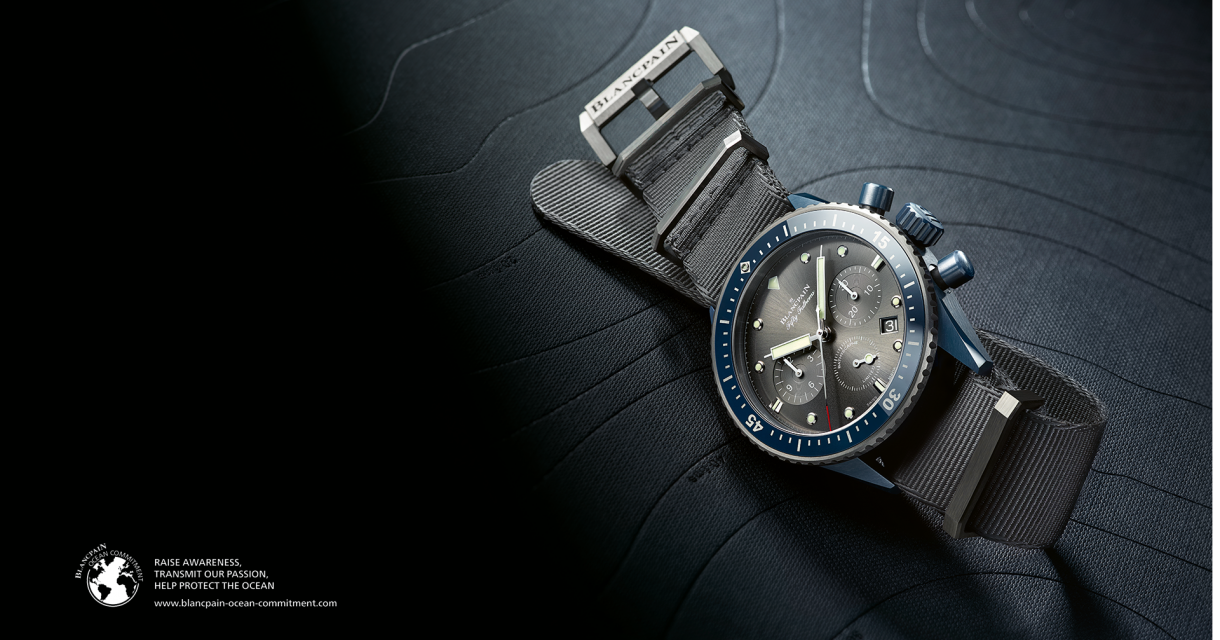
Search in Issues
Chapters
List of parts
Chapter 3
GOMBESSA III EXPEDITION
Antarctica: a frozen desert, an oasis of life...

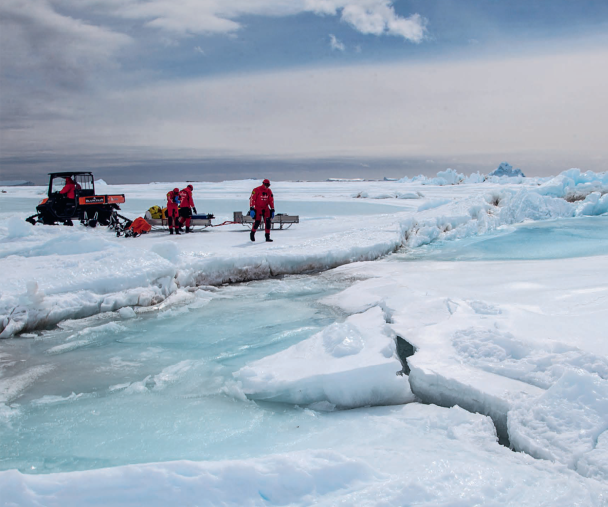
Crack in the ice floe near Dent Island.
I do not have my head in the stars, but firmly in ice flakes, and to cap it all, a blow to the top of the head with a spade serves to remind me of the harsh reality of the situation: a meter deep, imprisoned in the ice floe, or to be more exact, stuck in a morass of sparkling ice crystals. A day and a half of preparation for a humiliating ducking that lasts less than ten minutes at less than a meter underwater! Action replay...
Upon arrival this morning, a thin layer of ice had formed on the surface of the hole that we had drilled the day before in 3 m of ice. Black water finally appeared after we had removed most of the ice blocks still floating in the well. It was the first time that we were to dive through such a miniscule entrance so I decide to test the passage alone to start off with. I haul myself to the bottom as best I can with my hands, knees, heels and the tips of my fins. When I finally make it through the narrow opening, I notice that the floe does not look like a solid, flat ceiling as it does from the surface. It is a thick layer of ice flakes, which have started to move as a result of my descent. These millions of little crystals float and, pushed by Archimedes, converge on the wells that we have just opened. One should imagine a giant upside down sink whose viscous contents empty out from above... for a short moment, I think of going down and starting my exploration
THIS MOUNTING ICE SOUP is in the process of blocking the one and only exit!
while waiting for my mates who will follow shortly, but a bad feeling swiftly catches up with me: this mounting ice soup is in the process of blocking the one and only exit! Without the slightest hesitation, I give up and try to go back up. A third of the hole is already closed, in other words, about a meter, with icy mush.
With one hand raised, I manage, with difficulty, to push my arms into this half-liquid, half-solid stuff, but once I get up to my shoulders there is no way of getting any higher. With the other hand I inflate my vest in order to have greater lift but nothing helps. Fortunately we had set up a rope. I attempt to pull myself up but the hole is too narrow to allow me to bring my arm alongside my body. With infinite patience, I gain centimeter after centimeter. The situation becomes critical: the higher I hoist myself, the more I am stuck in the icy glue. So here I am stuck and half stunned.
The cranial trauma has had one advantage: to get Cédric to understand that I am a few dozen centimeters from the surface but paralyzed and invisible under the thick “porridge”.
Then I feel a hand grab mine at the same time as someone pulls the rope. Relief as I’m hoisted out! I hold on tight, as much with my hands as with my jaws in order to hang on to my mouthpiece which I am about to drop. A few seconds later, I am at last in the fresh air.
Nothing is easy when it comes to diving in the Antarctic!
The commitment and the limitations are so immense that every moment on the ground is exhausting and a source of inertia that is hard to overcome. Every day, six hours of preparation are required before getting in the water and sometimes hours on foot to reach a dive site. Then there is the question of getting kitted up. Four layers to put on one over the other: thermal underwear, followed by an electric heater bodysuit, then by a thick fleece and finally a waterproof neoprene suit. Added to this are a hood, underhood, heated gloves, protective waterproof gloves, fins, 16 kg
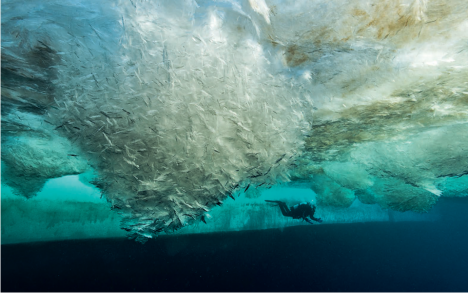
Ice crystal collection, north of Petrel Island.
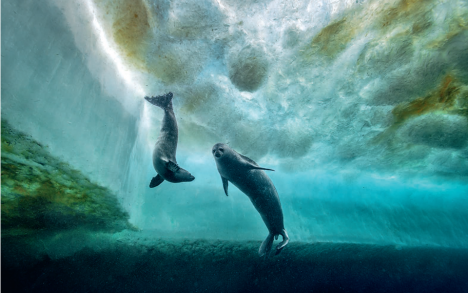
Mother and child Weddell seals (Leptonychotes weddellii) on the edge of the ice floe, northeast of the piste du lion (lion trail) connecting three Antarctic islands.
THE WATER UNDER THE FLOE APPEARS MORE TRANSPARENT THAN ANYWHERE ELSE, because no stray light interferes with the particles it carries.
of weights, heater batteries, rebreathers, backup gas cylinders and my photography equipment. We look like astronauts, minus the bubble helmet! After an hour of preparation with the invaluable help of Manu, the emergency doctor, we’re done and finally ready to topple into the freezing water with 90 kg of equipment on our backs! The cold bites our faces and swiftly the few square centimeters of exposed skin are anesthetized. The cold is therefore no longer our main cause of distress during the first hour of the dive and that’s fortunate. The whole of last year we attempted to identify the weak points of classic diving suits. Following this, we improved on existing options together with the manufacturers thereof.
The temperature underwater reaches just –1.8 °C and the calorie burn rate is infinitely faster. The cold in the water is so penetrating that it leads to hypothermia well before the slightest chilblain. Without a suit, one would die in less than ten minutes. With our equipment, we can withstand it for hours, up to five hours to be precise.
Naturally in cold like this, the challenge remains almost insurmountable. But once underwater, the brightness of this place suppresses any frustrations. It is amongst those sights that cure all ills. This water clarity is a blessing for the photographer. I owe this exceptional atmosphere to the ice. Of course it reduces the amount of light, but it improves its quality. The water under the floe appears more transparent than anywhere else, because no stray light interferes with the particles it carries. Amid cracks, or seal holes, wells of light form here and there and subtly light up the underwater landscapes. It is a fairytale of weak yet amazing lights, timid yet penetrating. In these unbearable temperatures, these rays are akin to heat sources, which warm the photographer’s eye. Entranced by them, for a second I forget the biting cold.
After a few weeks, we begin to get the hang of it. The preparation for dives is more streamlined, but remains very long. Our immersion also gets longer and deeper. The further down we go, the more striking the contrast between “earth” and “sea”: on the surface, it is the harshness of the environment that limits life, while underwater it seems to be characterized by its delicacy. One might believe oneself to be in the tropics. We visit luxuriant gardens of animal life that are impossible to imagine when on the surface in the polar desert. Most of the species encountered are endemic. These exceptional living beings successfully adapted to the southern polar ocean when it became isolated 35 million years ago.
The deeper it gets, the richer the biodiversity, as life is compromised on the surface due to sudden changes in salinity levels, highly toxic for marine organisms. Between 10 and 15 m, kelp forests take over
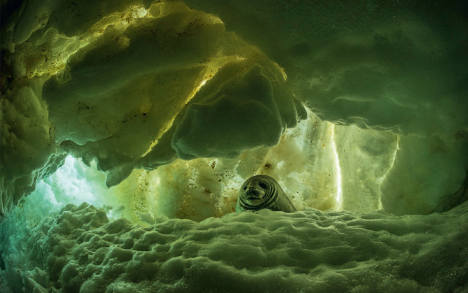
Newborn Weddell seal (Leptonychotes weddellii), Dent Island.
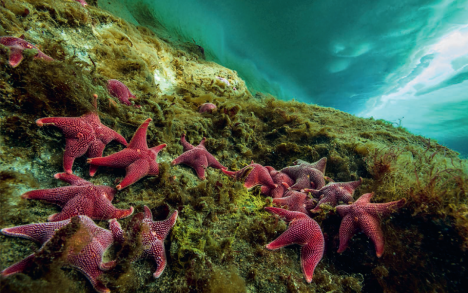
Starfish (Odontaster validus), Dent Island. Depth: 5 m.
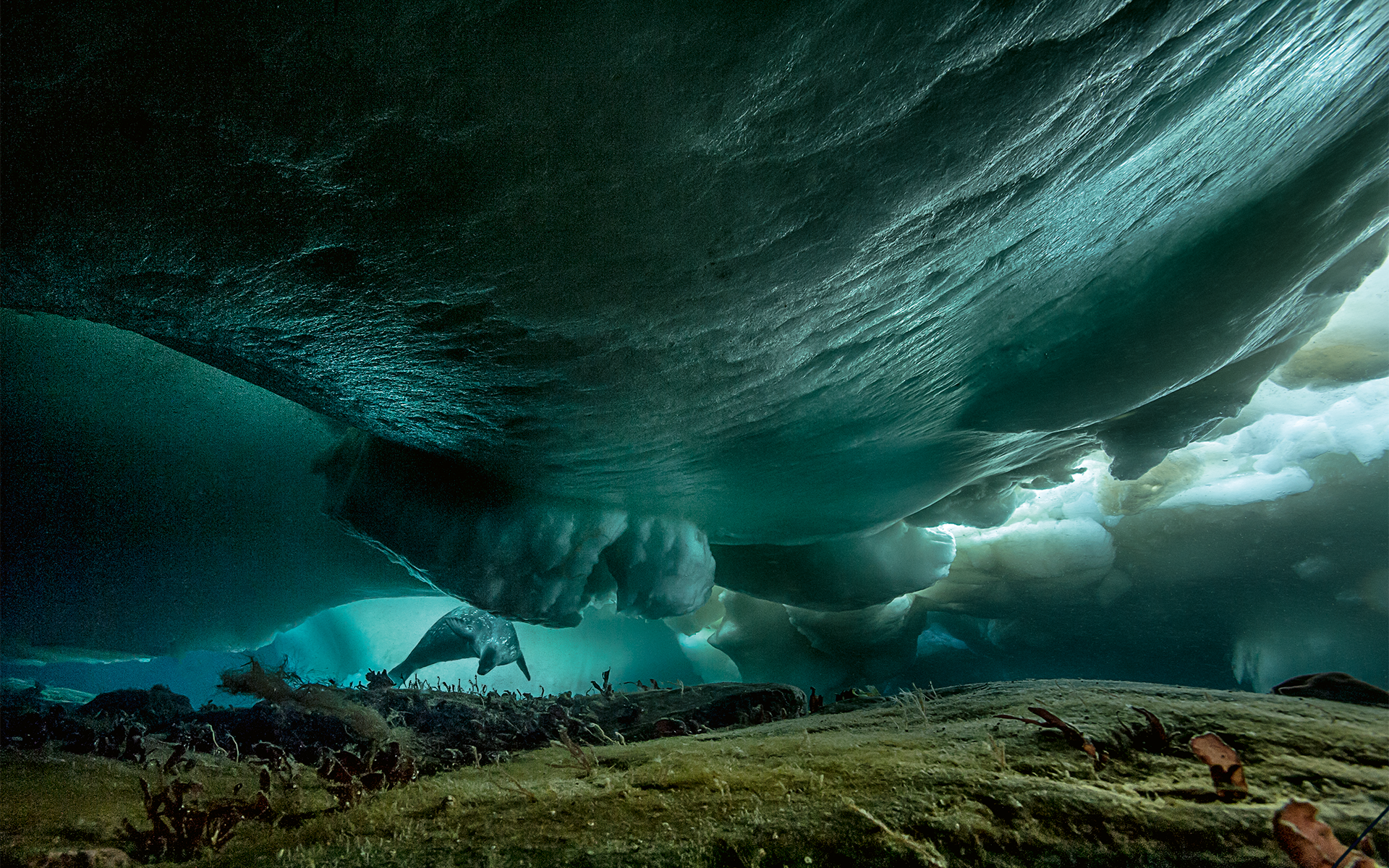
the landscape. The kelp in question has unique leaves that are almost 4 m long, creating a setting that is simultaneously imposing and sober. Continuing with our descent, we encounter a number of Macroptychaster accrescens or starfish that are about 40 cm in diameter, much bigger thanthose in warmer seas, and then a Colossendeis megalonyx, Antarctica’s Pantopoda or giant sea spider, typical of the poles with its spider-like allure. Admittedly, this group of marine arthropods is to be found in all the world’s oceans, but is only represented by rare species that are virtually invisible to the naked eye when one dives in temperate and tropical latitudes. It is only in polar oceans that sea spiders have expanded and reach incredible widths of up to several dozen centimeters. They are a magnificent sight to behold. Their bodies are so restricted that their internal organs have to be housed in their legs.
At 50 m, the lack of light prevents algae from developing, thus making space for fields of sea pens. In places, these hydroids form thick carpets. Elsewhere are fields of thousands of scallops, a kind of small coquille Saint-Jacques, but which takes 90 years to reach 10 cm wide. Everything takes time in the Antarctic. It is at these depths that we notice the crinoids, Promachocrinus kerguelensis. Close relatives of the starfish, attached to the seabed by a stalk, they move by undulating their 15 feather-covered arms. Their appendages also enable them to filter waters rich in plankton.
We also see some Glyptonotus antarcticus, Antarctica’s giant isopod which resembles a sea beetle, as capable of swimming as it is of walking on the seabed. From 70 m onwards, a wide variety of life cohabits. In just a single square meter, thousands of species live together: gorgonian sea fans, shellfish, soft corals, sponges, little fish... I am convinced that nobody, out of context, would guess that the photographs of these undersea gardens were taken in the Antarctic, which, with their incredible diversity of scenery, colors and exuberance, are reminiscent of tropical coral reefs. All these fixed invertebrates, these animals in plant form, seem to have attained huge proportions and if nothing interferes with them, their growth appears limitless in this enormously stable universe. Conversely, the slightest disturbance in the environment is destructive. Ultra-adapted, slow to develop, how can these creatures withstand current climate changes?
The dives take place in a numbing routine. The ice conditions change quickly and spotting is required, given the extent to which the area metamorphoses from one day to the next. We slide into holes dug by seals with their canines when they com up to breathe. We too need our exit hole. The greatest dread of every diver in the polar region is to get lost under the ice floe and be unable to come up again. To avoid this, we have a guiding thread: a bright yellow, luminous liana that we are able to see despite the lack of light. This is our marker and we never stray far from it. How do these Weddell seals manage without this Ariadne’s thread? It must be thanks to the earth’s magnetic field and some sort of built-in compass in their heads.
We enter the water and I discover the most beautiful lights that I have ever seen in my life. Underneath, the ice is yellow, green and orange. Behind the scenes, the decor is worthy of a rainbow. Microalgae are responsible for these multicolored paintings. It is akin to a harbinger: these unexpected colors magnificently symbolize the entrance to another world. After such a spectacular beginning, it is clear that nothing that awaits us on the bottom will be commonplace. These flamboyant algae are the sentries: they give us gentle warning of the brutal surprise which awaits us further down. It is spellbinding - we are in the midst of icy havoc, a veritable labyrinth.
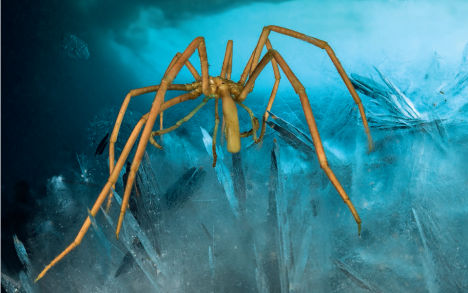
Giant Antarctic Pantopoda or sea spider (Colossendeis megalonyx), Claude Bernard Island. Depth: 14 m.
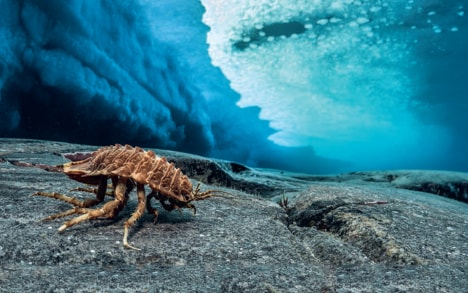
Giant Antarctic isopod (Glyptonotus antarcticus), island southeast of La Selle. Depth: 14 m.
THE GREATEST DREAD OF EVERY DIVER in the polar region is to get lost under the ice floe and be unable to come up again.
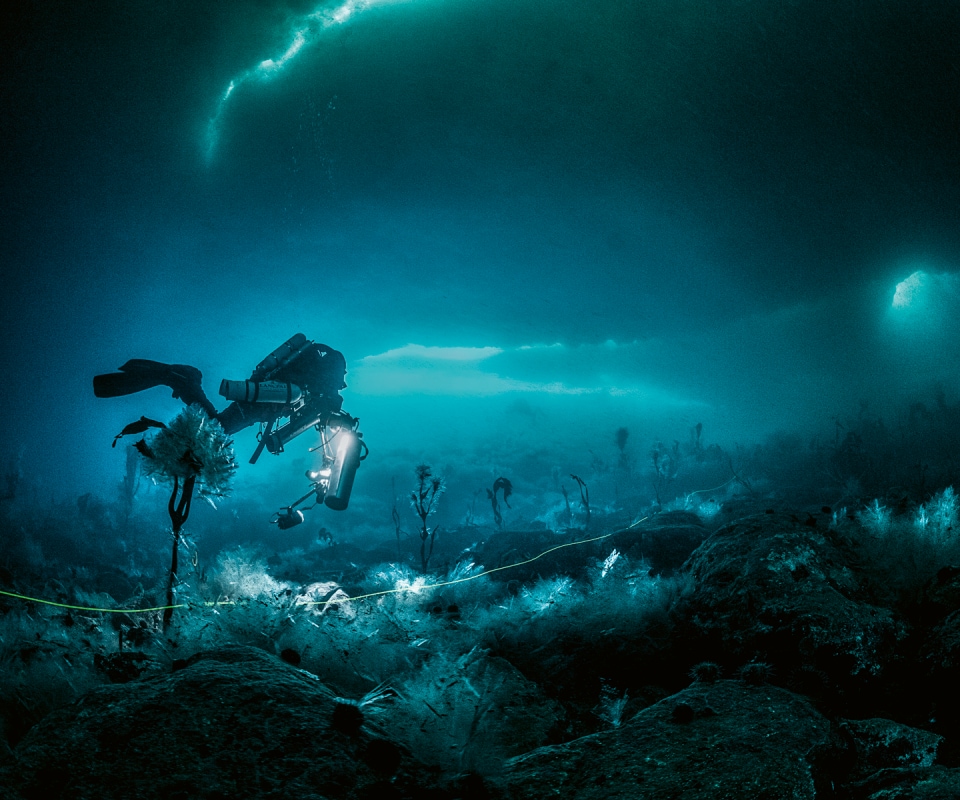
Under the frozen chaos, ice crystals on kelp, Cap des Entailles. Depth: 19 m.
THE SETTING IS FAIRYLIKE and one could quite easily think that one was in science fiction surroundings!
As I return to the hole, I notice seal heads, a mother and her baby. I wait a little and finally, they enter the water. I watch them for a long moment as they inhabit this multicolored labyrinth. The setting is fairylike and one could quite easily think that one was in science fiction surroundings! The contrast between men and animals is striking: for us, it is already extremely difficult to simply move underwater with our heavy equipment, while the Weddell seals glide easily and are capable of diving to depths of 900 m. It’s so easy for them...
The end of the expedition nears, each dive counts, but this one is especially dear to my heart. For the past two years I have been dreaming about being at this most remote point on the Dumont d’Urville map: the Norsel reef. When we arrived, it was alongside the floe. Since the melting, it has been in the open sea and therefore inaccessible by vehicle. We get there by helicopter. This pristine site is a spire of rock in the middle of the water, topped with a little ice cap. It is surrounded by 200 m depths. Flying over it is spectacular. The rocky outline of the site protects it from icebergs, so well, in fact, that one of its faces has never been scraped by ice. Life here must be protected and has developed plentifully. When the helicopter drops us, we are more than 10 km from the base, in the middle of the sea, facing the continent and surrounded by giant icebergs. This is an exceptional situation. I think we are all aware of the privilege of being here: on this spot where nobody before us has ever dived. Cédric grabs the chain saw and cuts a staircase in the ice to which we fix a ladder to help us climb back up. It is very mild outside, perhaps even 0 °C, almost balmy. Summer is coming but the water is still just as icy: –1.8 °C. We jump from our icy springboard and Manu, the doctor, activates the chronometer. We’re off for a three and a half-hour soak in another world, the underwater world of the Antarctic.
Every time we have dived, we have returned with creatures and universes that have never been photographed before. But the most bothersome thing is that, despite so many daily discoveries, my gut feeling is that we have but skimmed over the subject, and that there are still so many underwater landscapes and species to reveal for the first time. We could start all over again without getting in the slightest bit bored. This trip has been so intense that I have the feeling I have experienced the entire expedition as a single, ongoing 50-day-long dive. It undoubtedly took a considerable time to start, when I think of the endless journey and the long initial days of setting up the equipment, but from the moment we put our heads underwater, it just never stopped-dive, pre-dive and post-dive it was all so energy-intensive, packed, relentless, with sleep so deep and so instantaneous that no time has been left for reflection, with the aim of obtaining a little perspective. Such an incredible sequence of events leaves me with a feeling of but a single, unique and continuous dip; not a succession of lived experiences but rather a single, compact slice of life.
The commitment and the risks also have their upsides in terms of a kind of transcendence. The moments when I give of my best are, it appears, when photographic conditions become the most difficult. The biting cold, the trap of being under the ice floe, the lack of light, the great depths in which most of the creatures hide away, everything is challenging. And it is precisely because every shot is hard to take that the exercise becomes as fascinating as it is alienating.
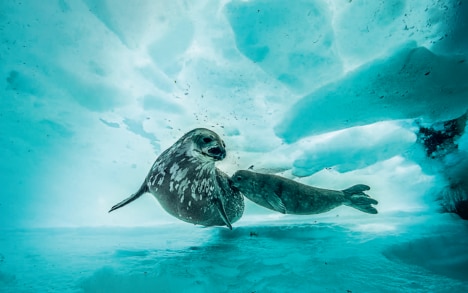
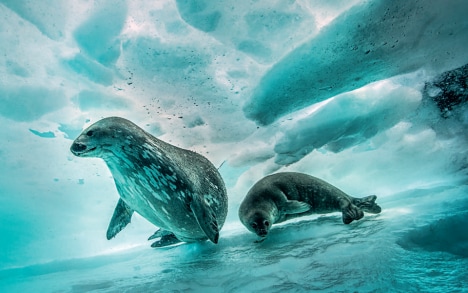
Mother and child Weddell seals (Leptonychotes weddellii), Dent Island. Depth: 2 m.
THE MOMENTS WHEN I GIVE OF MY BEST are, it appears, when photographic conditions become the most difficult.
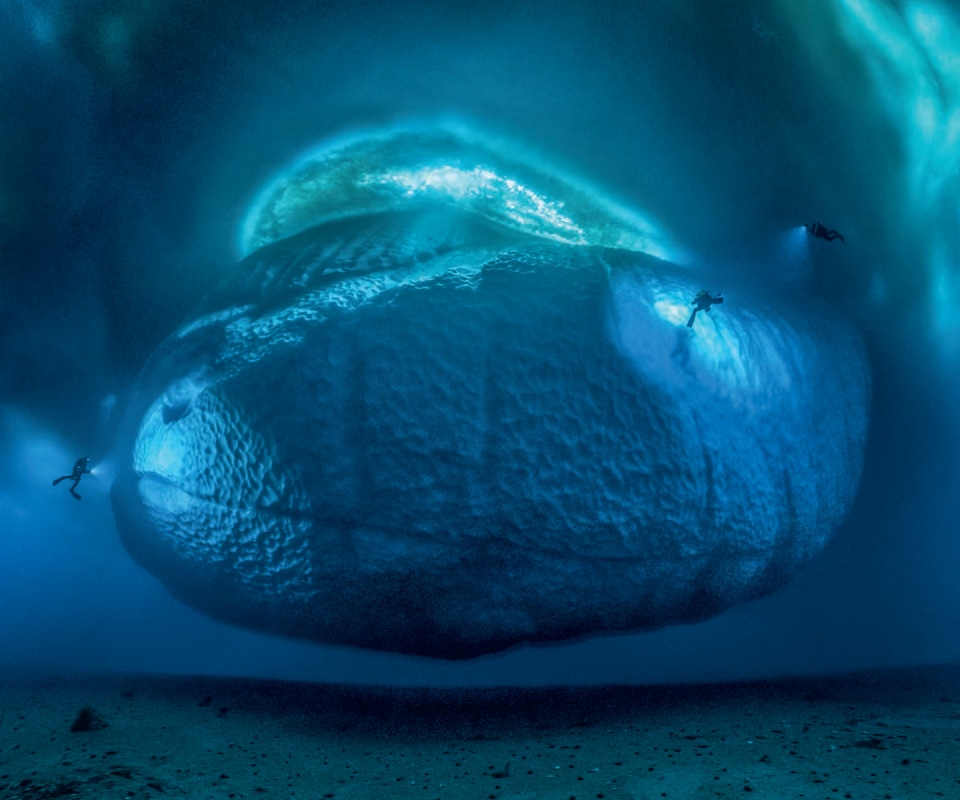
Submerged section of an iceberg southwest of the Îlot de la Vierge. Depth: 30 m.
DOWN THERE, THERE IS NEITHER GOOD LIVING nor the welcome of luxuriant surroundings. It is something else down there.
The logistical weight of the dives also has an upside: it creates solidarity within the team. I have never felt so well supported. I don’t think we have ever been this close to one another. And when the exhaustion starts to manifest itself, when the idea of giving up surreptitiously raises its head, the solution lies in the team. Not that one gives way to gentle affection but, on the contrary, by indulging in unsubtle jokes. The tomfoolery is a delicate way of pulling ourselves together, and mocking some members of the group cheers up the others.
The expression “being worth it” has never been so accurate because while the dives are painful, they are always fruitful. The images we bring back have a particular value: they are unprecedented mostly because there are undoubtedly fewer men that have dived here than have summited Mount Everest. Here, the challenge is more to do with taking original underwater photographs than just diving. At the heart of this hostile environment, where one survives rather than actually lives, diving might appear to be an act of pure provocation given that these waters, as magical as they are, are inhospitable to simple primates such as ourselves. One has to have chosen to do these dives, to be sure of one’s desire and curiosity and taste for exploration. In the Antarctic, one cannot feign one’s passion. One cannot go down there by default, the demands are far too great for anyone that is half-hearted about it.
Forget conventional ideas of what pushes us to extremes. Down there, there is neither good living nor the welcome of luxuriant surroundings. It is something else down there. Despite the unspeakably harsh climate, there are bright sides to be found. It’s just that they are scarce and subtle. In this era of an overpopulated, ultra-connected world abounding with artificial enjoyment, it transpires that solitude and isolation are becoming rare luxuries in our time. The Antarctic is able to offer this. These gifts nevertheless come at a price
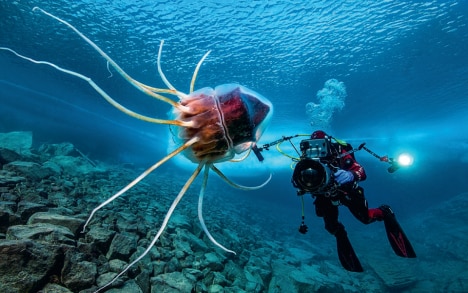
Helmet jellyfish (Periphylla periphylla), found in Antarctica as well as in the Arctic. Depth: 12 m.

Ice fingers under the ice floe, La Baleine Island. Depth: 5 m.
GOMBESSA III For their third Gombessa Expedition, Laurent Ballesta and Blancpain travelled to Antarctica for a pioneering exploratory, diving and photographic mission. This expedition was part of a wider meta-project initiated by movie director Luc Jacquet (who won an Academy Award for Best Documentary Feature in 2006 with March of the Penguins) to measure the impact of global warming in this polar region, and to capture the attention of the general public.
and involve accepting a certain dose of suf- fering. But that matters little, since during these taxing dives, during which our extremities-both feet and hands-freeze and swiftly lose all sensitivity, internal feelings, conversely, are on a perpetual boil. When one discovers life-lives remote from all life-in the heart of these depths, so inclement when it comes to human survival, more than ever one experiences the soul of an explorer. At the dawn of the third millennium, where, on our little planet, can one still conceive of being the first to observe a pristine piece of nature?
Unquestionably in the polar depths untouched by human hand or diving finshod feet... You may smile, but when we dive down there in the Antarctic, that is exactly how we feel! I sincerely hope you will feel it too as you immerse yourself in this account.
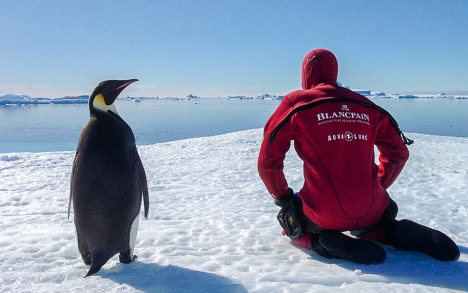

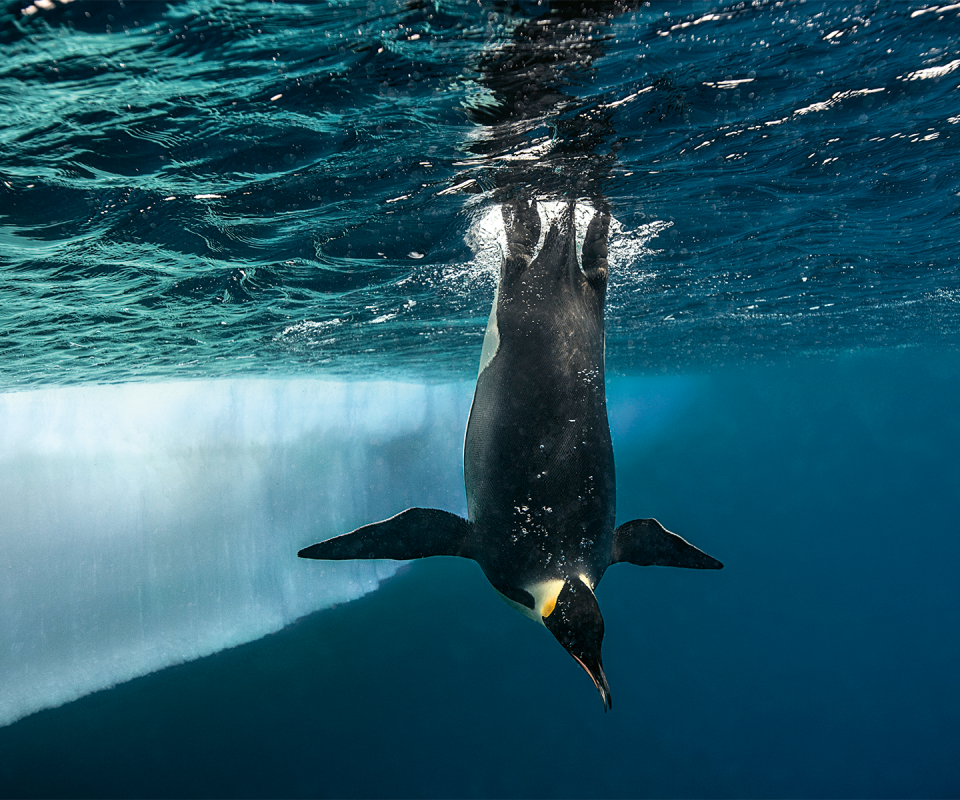
Emperor penguins, edge of the ice floe, north of Petrel Island.

